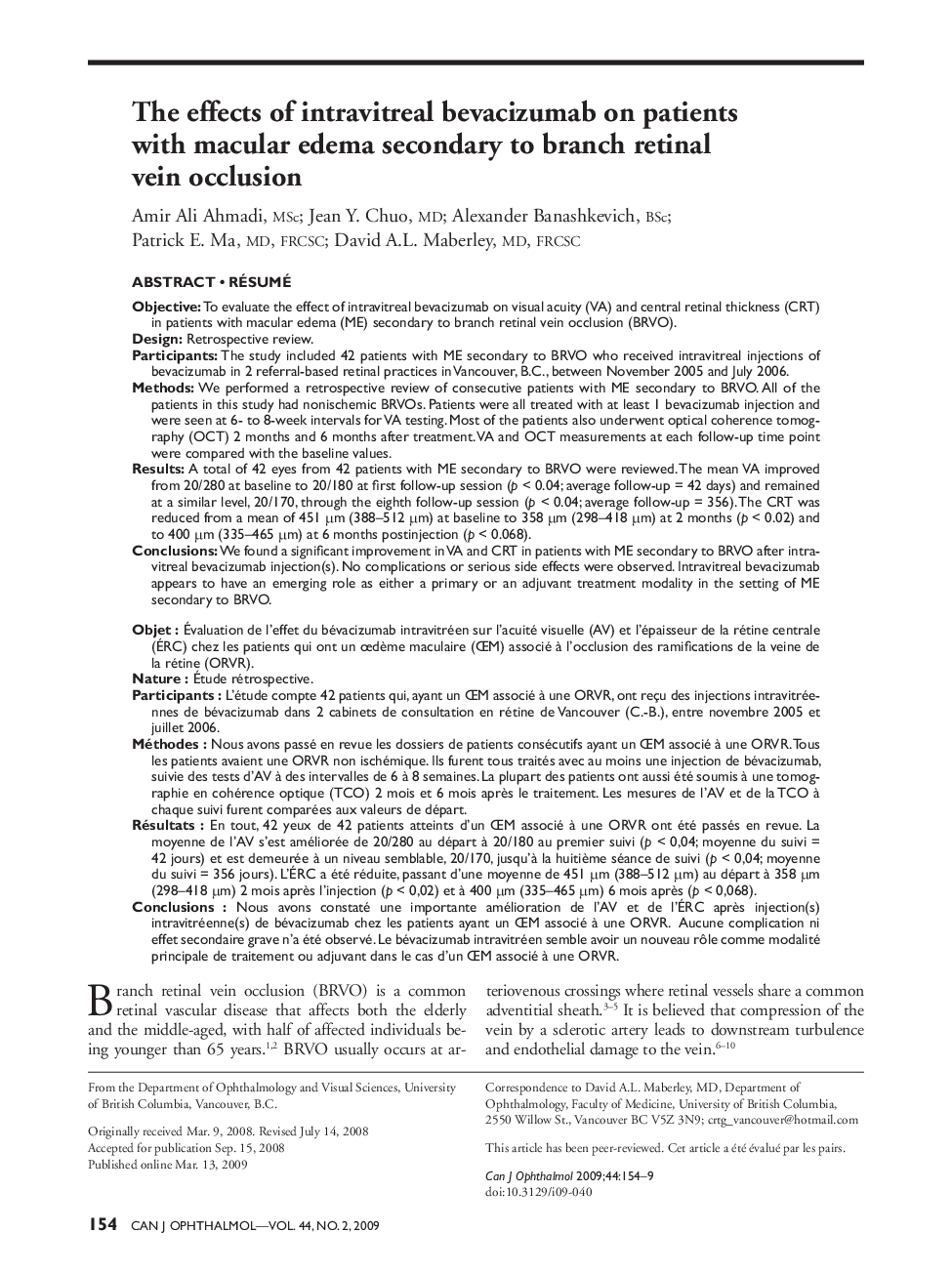| کد مقاله | کد نشریه | سال انتشار | مقاله انگلیسی | نسخه تمام متن |
|---|---|---|---|---|
| 4009955 | 1602436 | 2009 | 6 صفحه PDF | دانلود رایگان |

Objective: To evaluate the effect of intravitreal bevacizumab on visual acuity (VA) and central retinal thickness (CRT) in patients with macular edema (ME) secondary to branch retinal vein occlusion (BRVO).Design: Retrospective review.Participants: The study included 42 patients with ME secondary to BRVO who received intravitreal injections of bevacizumab in 2 referral-based retinal practices in Vancouver, B.C., between November 2005 and July 2006.Methods: We performed a retrospective review of consecutive patients with ME secondary to BRVO. All of the patients in this study had nonischemic BRVOs. Patients were all treated with at least 1 bevacizumab injection and were seen at 6- to 8-week intervals for VA testing. Most of the patients also underwent optical coherence tomography (OCT) 2 months and 6 months after treatment. VA and OCT measurements at each follow-up time point were compared with the baseline values.Results: A total of 42 eyes from 42 patients with ME secondary to BRVO were reviewed. The mean VA improved from 20/280 at baseline to 20/180 at first follow-up session (p < 0.04; average follow-up = 42 days) and remained at a similar level, 20/170, through the eighth follow-up session (p < 0.04; average follow-up = 356). The CRT was reduced from a mean of 451 μm (388–512 μm) at baseline to 358 μm (298–418 μm) at 2 months (p < 0.02) and to 400 μm (335–465 μm) at 6 months postinjection (p < 0.068).Conclusions: We found a significant improvement in VA and CRT in patients with ME secondary to BRVO after intravitreal bevacizumab injection(s). No complications or serious side effects were observed. Intravitreal bevacizumab appears to have an emerging role as either a primary or an adjuvant treatment modality in the setting of ME secondary to BRVO.
RésuméObjet: Évaluation de l’effet du bévacizumab intravitréen sur l’acuité visuelle (AV) et l’épaisseur de la rétine centrale (ÉRC) chez les patients qui ont un œdème maculaire (ŒEM) associé à l’occlusion des ramifications de la veine de la rétine (ORVR).Nature: Étude rétrospective.Participants: L'étude compte 42 patients qui, ayant un ŒEM associé à une ORVR, ont reçu des injections intravitréennes de bévacizumab dans 2 cabinets de consultation en rétine de Vancouver (C.-B.), entre novembre 2005 et juillet 2006.Méthodes: Nous avons passé en revue les dossiers de patients consécutifs ayant un ŒEM associé à une ORVR. Tous les patients avaient une ORVR non ischémique. Ils furent tous traités avec au moins une injection de bévacizumab, suivie des tests d’AV à des intervalles de 6 à 8 semaines. La plupart des patients ont aussi été soumis à une tomographie en cohérence optique (TCO) 2 mois et 6 mois après le traitement. Les mesures de l’AV et de la TCO à chaque suivi furent comparées aux valeurs de départ.Résultats: En tout, 42 yeux de 42 patients atteints d’un ŒEM associé à une ORVR ont été passés en revue. La moyenne de l’AV s'est améliorée de 20/280 au départ à 20/180 au premier suivi (p < 0,04; moyenne du suivi = 42 jours) et est demeurée à un niveau semblable, 20/170, jusqu'à la huitième séance de suivi (p < 0,04; moyenne du suivi = 356 jours). L'éRC a été réduite, passant d’une moyenne de 451 μm (388–512 μm) au départ à 358 μm (298–418 μm) 2 mois après l’injection (p < 0,02) et à 400 μm (335–465 μm) 6 mois après (p < 0,068).Conclusions: Nous avons constaté une importante amélioration de l’AV et de l’ÉRC après injection(s) intravitréenne(s) de bévacizumab chez les patients ayant un ŒEM associé à une ORVR. Aucune complication ni effet secondaire grave n'a été observé. Le bévacizumab intravitréen semble avoir un nouveau rôle comme modalité principale de traitement ou adjuvant dans le cas d’un ŒEM associé à une ORVR.
Journal: Canadian Journal of Ophthalmology / Journal Canadien d'Ophtalmologie - Volume 44, Issue 2, April 2009, Pages 154-159